U.S. NAVAL AVIATION RESOURCE CENTER > FIGHTERS > PREVIOUS PAGE

(Source: U.S. Navy)
Design and development
The FF-1 was Grumman’s first aircraft design for the US Navy. The prototype XFF-1 (serial number A8878) was built to a contract placed on 22 April 1931, first flying on 29 December of that year. A two-seat design, with an enclosed cockpit, fuselage of all-metal construction, and wings covered largely with fabric. The XFF-1 was powered initially by a 616 hp (459 kW) Wright R-1820-E Cyclone radial engine, it achieved 195 mph (314 km/h) during service trials, and when the original engine was exchanged for a 750 hp (560 kW) Wright R-1820-F Cyclone the XFF-1 reached a top speed of 201 mph (323 km/h), faster than any US Navy fighter in service at the time.
A production order was placed for 27 two-seat FF-1 (G-5) on 19 December 1932. Meanwhile Grumman had completed a second prototype (serial number A8940) to a two-seat scout configuration as the XSF-1 (G-6). Subsequently 33 production SF-1s were ordered based on the two-seat configuration. They differed from the FF-1 principally in having revised internal equipment and in being powered by R-1820-84 Cyclones instead of the R-1820-78 model installed in the fighter version. One XSF-2 was also completed, this having a Pratt & Whitney R-1830 Wasp engine in place of the Cyclone.
Operational history
FF-1s were delivered to Fighter Squadron VF-5B of the USS Lexington beginning in June of 1933. In service the FF-1 became familiarly known as the "Fifi". Delivery of SF-1s started in 30 March 1934, and they also served aboard the Lexington, with Scout Squadron VS-3B.
Both the FF-1 and SF-1 were withdrawn from first-line US Navy squadrons by the end of 1936 and reallocated to reserve units, most of the FF-1s still being in service late in 1940. Later, 22 surviving FF-1s were modified with dual controls, redesignated FF-2 and used for instructional duties.
The Canadian Car & Foundry Co acquired a manufacturing licence for the FF-1, of which it completed a total of 57, some of them assembled from US-built components. Although initially rejected as a fighter by the Royal Canadian Air Force as outdated and too slow, with the advent of war, the last 15 of the CC&F production batch were accepted as the Goblin I. The aircraft type served with the RCAF from 17 September 1940 until 21 April 1942. "A" Flight of No. 118 RCAF Sqn was equipped with Goblins at Rockcliffe in Ottawa, and subsequently became No. 118 (Fighter) Sqn., later stationed at Dartmouth, Nova Scotia where the Goblins for a time constituted the sole fighter force on the east coast.

CC&F Goblin I circa 1941. (Source: Royal Canadian Air Force)
Sources:
Wikipedia: Grumman FF
U.S. NAVAL AVIATION RESOURCE CENTER > FIGHTERS > PREVIOUS PAGE
